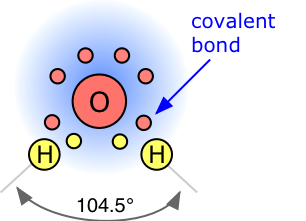On this page:
- Water the molecule
- Hydrogen bonding
- Anomalous properties
- Surface tension and wetting
- Water the liquid
- Local structures and clusters
- Liquid and solid water
- "Pure" water
- Drinking water
- Water in our bodies
- Bound water
- Biowater
- Water pseudoscience
- Structure-altered waters
- Does water have memory?
- Run your car on water?
- Some references on water
- Water art and music

The molecule of water
A molecule is an aggregation of atomic nuclei and electrons that is sufficiently stable to possess observable properties — and there are few molecules that are more stable and difficult to decompose than H2O. In water, each hydrogen nucleus is bound to the central oxygen atom by a pair of electrons that are shared between them; chemists call this shared electron pair a covalent chemical bond. In H2O, only two of the six outer-shell electrons of oxygen are used for this purpose, leaving four electrons which are organized into two non-bonding pairs. The four electron pairs surrounding the oxygen tend to arrange themselves as far from each other as possible in order to minimize repulsions between these clouds of negative charge. This would ordinarly result in a tetrahedral geometry in which the angle between electron pairs (and therefore the H-O-H bond angle) is 109.5°. However, because the two non-bonding pairs remain closer to the oxygen atom, these exert a stronger repulsion against the two covalent bonding pairs, effectively pushing the two hydrogen atoms closer together. The result is a distorted tetrahedral arrangement in which the H—O—H angle is 104.5°.

